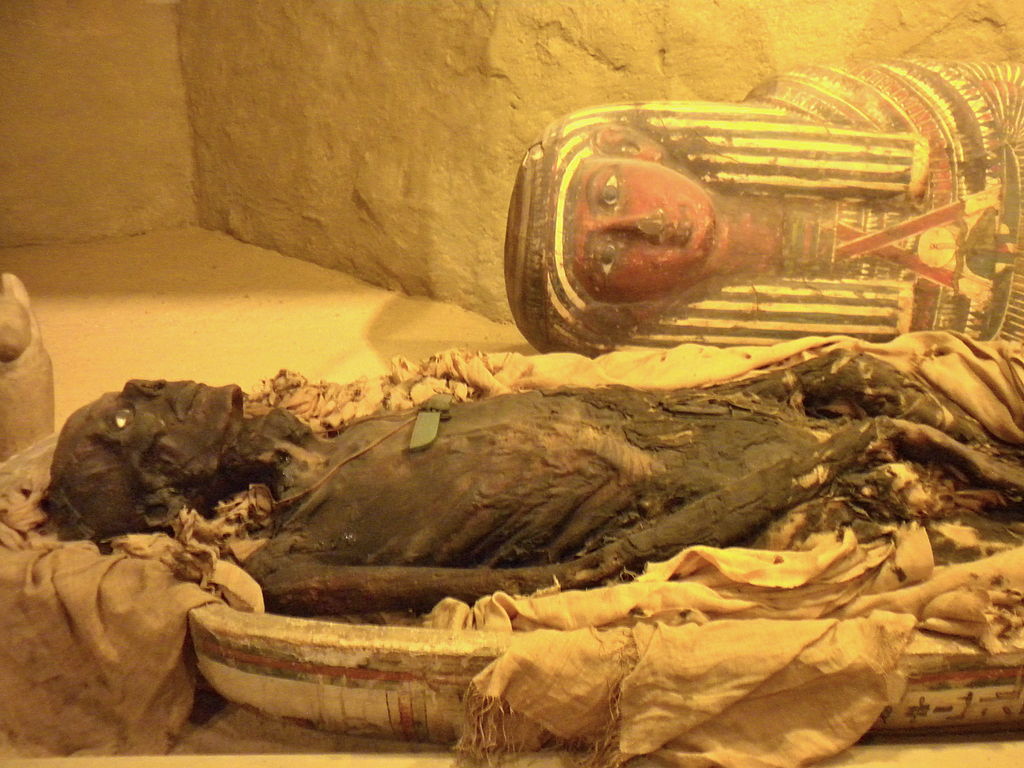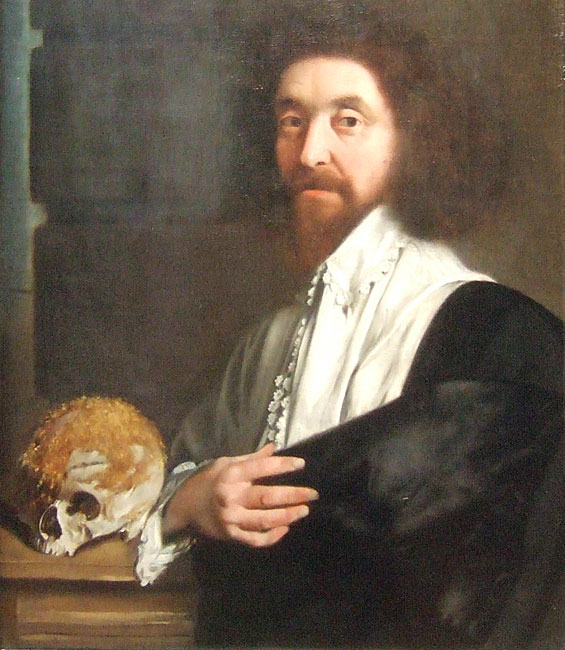
Mummy on display at the Philadelphia Academy of Natural Sciences.
Audio brought to you by Curio, a Lapham’s Quarterly partner
For hundreds of years, Europeans regularly consumed human flesh and blood. The practice was widespread among both the poor and the aristocracy—including at least a few members of British royalty. Although the specifics varied according to place and time, such cannibalism reached its peak in Germany, England, Italy, and France toward the end of the Renaissance, just as Europe was supposedly shaking off its long intellectual slumber and heading into the warm glow of the Enlightenment. As barbaric as it seems today, the drinking of human blood, the smearing of human fat, and the distilling of human bones into a much-prized spirit were all done for a single purpose: healing.
For most of us today, the corpse is an object of horror or revulsion, but for the early moderns it contained potent mystical properties. Many of these recipes relied on sympathetic magic: powdered blood helps bleeding, human fat helps bruising, skulls help with migraines or dizziness. Physicians and patients believed that ingredients obtained from corpses were most potent if they had died violently. For instance, the great sixteenth-century physician Paracelsus wrote that after a man was hanged, his “vital spirits” would “burst forth to the circumference of the bone.” It was thought that when death came suddenly, a person’s spirit could stay trapped within its mortal coil for at least enough time that the living might benefit from its power.
While epileptics of ancient Rome drank the blood of slain gladiators, the beverage found particular favor as a health tonic during the Renaissance. The blood was typically harvested from the freshly dead, but could also be taken from the living. Such medicinal vampirism had no shortage of adherents: Marsilio Ficino, a highly respected fifteenth-century Italian scholar and priest, said that elderly people hoping to regain the spring in their step should “suck the blood of an adolescent” who was “clean, happy, temperate, and whose blood is excellent but perhaps a little excessive.” Another popular remedy, sometimes attributed to Saint Albertus Magnus, involved distilling the blood of a healthy man as if it were rose water; the result was said to cure “any disease of the body,” and “a small quantity…restoreth them that have lost all their strength,” according to one 1559 text. By the 1650s there was a general belief that drinking fresh, hot blood from the recently deceased would cure epilepsy, as well as help with consumption. Meanwhile, dried and powdered blood was recommended for nosebleeds or sprinkled on wounds to stop bleeding.
If fresh or powdered blood proved somehow inconvenient, one could also follow the recipe for blood jam given by a Franciscan apothecary in 1679. As recounted by Richard Sugg in his 2011 book Mummies, Cannibals and Vampires: The History of Corpse Medicine from the Renaissance to the Victorians, the first step was to take blood “from persons of warm, moist temperament, such as those of a blotchy, red complexion and rather plump of build.” The next step was to “let it dry into a sticky mass.” After that:
Place it upon a flat, smooth table of soft wood, and cut it into thin little slices, allowing its watery part to drip away. When it is no longer dripping, place it on a stove on the same table, and stir it to a batter with a knife…When it is absolutely dry, place it immediately in a very warm bronze mortar, and pound it, forcing it through a sieve of finest silk. When it has all been sieved, seal it in a glass jar. Renew it in the spring of every year.
Blood was far from the only component of the human body deemed medicinally useful. Another, arguably more popular, ingredient in the medical treatises and apothecaries of Renaissance Europe was mumia, or mummy. While today we associate mummies with museums and sometimes horror movies, their initial source of interest for Europeans was medicinal. The term itself has undergone an odd evolution, noted Sugg, who drew on the research of historian Karl Dannenfeldt to show how the word transformed from mumiya, for wax—used in early Arabian medical writings to refer to a natural mineral pitch found on certain mountainsides in Persia—to the mummy of the eleventh century, a “pitch-like substance, produced in Egyptian corpses by the arts of mummification.” By the twelfth century mummy began to refer more to the corpse and less to the pitch used to preserve it, until it lost its earlier association entirely. (It could also refer to bodies preserved by North African sandstorms and whole corpses, often of executed felons, preserved in the manner advised by Paracelsus—which involved days of treatment with herbs before hanging the flesh out to dry, with the resulting product looking like cured meat.)
European demand for mummy grew significantly in the fifteenth century, when merchants began plundering Egyptian tombs and bringing the results back to the apothecaries of Europe. In the late sixteenth century, surgeon Ambroise Paré claimed it was “the very first and last medicine of almost all our practitioners” against bruising. Mummy was a significant commodity by the eighteenth century, taken in tinctures for bleeding or used in plasters against venomous bites or joint pain—so significant, in fact, that there was also a thriving trade in fraudulent mummy made from the poor, criminals, or animals. (In 2007 relics found in a Parisian pharmacy and said to belong to Joan of Arc were shown to come from an Egyptian cat mummy.) Mummy was also made into a pigment beloved by the Pre-Raphaelites called “mummy brown.” Both medicine and paint could be found for sale in some European pharmacies into the twentieth century.
While mummy was seen as virtually a panacea—an entire apothecary cabinet wrapped up in dried brown flesh—human fat was also a valued remedy. It was rubbed on the skin to ease the pains of gout and taken internally (in powdered form) to help with bleeding or bruising. It could also be used in the form of plasters. Sir Theodore Turquet de Mayerne—physician to several English and French kings as well as to Oliver Cromwell—recommended a pain-killing plaster made of hemlock, opium, and human fat. In 1694 Paris you could buy fat made from people at the drugstore, although there was more to be had if you went straight to the executioner. In Munich, Sugg found, the executioner delivered fat to the city’s apothecaries by the pound until the mid-eighteenth century.
Skulls were another commodity prized for their healing powers. The seventeenth-century English physician John French offered at least two recipes for distilling skulls into spirits, one of which he said not only “helps the falling sickness, gout, dropsy” and stomach troubles but also was “a kind of panacea.” (The other recipe was better for “epilepsy, convulsions, all fevers putrid or pestilential, passions of the heart.”) English king Charles II, an enthusiastic chemist with his own laboratory, is reported to have paid six thousand pounds to a professor at a local college for a recipe for distilled powdered skull, which thereafter became known as “the king’s drops.” The remedy was popular for a variety of complaints and seems to have often been mixed into wine or chocolate. In at least one case it was used as a sort of “mother’s little helper” by a woman named Anne Dormer, who wrote in 1686 to her sister Lady Elizabeth Trumbull: “I apply myself to tend my crazy health, and keep up my weak shattered carcass, broken with restless nights and unquiet days. I take the king’s drops and drink chocolate, and when my soul is sad to death I run and play with the children.” Moss that had grown on skulls, known as usnea, was thought to be especially powerful; it was pushed up the nose to stop nosebleeds. (It actually may have helped, as any powdered substance would have.)

Medical cannibalism and vampirism became most pervasive just when reports of New World cannibalism begin to circulate among Europeans. For people such as Joseph Hall, bishop of Exeter, who in a 1634 sermon raged against “bloody Turks, man-eating cannibals, mongrel troglodytes feeding upon buried carcasses,” cannibalism became shorthand for all that was abject, excessive, and taboo. It was an “imaginative black hole,” wrote Sugg, that “sucked in a variety of other transgressions or taboos and formed the boundary marker of a realm into which good Christians dare not enter.” Used as a symbol of everything basest in human nature, New World cannibalism was also employed to dehumanize the native inhabitants and justify their slavery.
Barbarism, of course, is relative (“barbarous” originally just meant anyone who wasn’t Greek), a point Montaigne made in his essay “On Cannibalism” when he compared the cannibalism of Brazil to the violence of sixteenth-century religious wars. But what many Europeans failed to grasp was that for Native Americans, cannibalism was eminently social and occurred only within a well-defined set of rituals. Far from being “senseless violence,” it was often found as part of mourning rituals meant to reintegrate the deceased into the tribe, as with the Wari of Brazil or among other tribes in Peru, Paraguay, and Venezuela. In many of these tribes, funerary cannibalism was part of a multiday ceremony where even the youngest infants took some broth simmered with the flesh of the deceased as a means of incorporating the dead into the future life of the tribe. Burial in the cold, wet ground seemed as horrific to them as human stew does to us. Even among tribes practicing aggressive cannibalism, war captives were consumed as part of a religious ceremony that sometimes was preceded by months of special treatment as an honored guest.
Europeans, by contrast, consumed the dead as other. The medicinal ingredients made from corpses came not from friends or loved ones but from the most abject members of society—executed criminals, the poor, the unknown. During the seventeenth century the English imported Irish skulls plucked from battlefields to be sold to the pharmacies of Germany; for the English, the Irish were seen as deeply inferior. As Sugg noted, “corpse medicines were often derived from bodies alienated, in various ways, from ordinary humanity—distant, most of all, from you (whether you were merchant, thief, apothecary, physician, or patient). In many ways, the Irish perfectly fulfilled this criterion in the minds of the English.” It’s a small example, but one that serves to reinforce a theme: the Europeans ate strangers, while the indigenous peoples of the New World ate friends. Whichever practice seems the less civilized depends on you, dear reader.
Explore Flesh, the Fall 2016 issue of Lapham’s Quarterly.